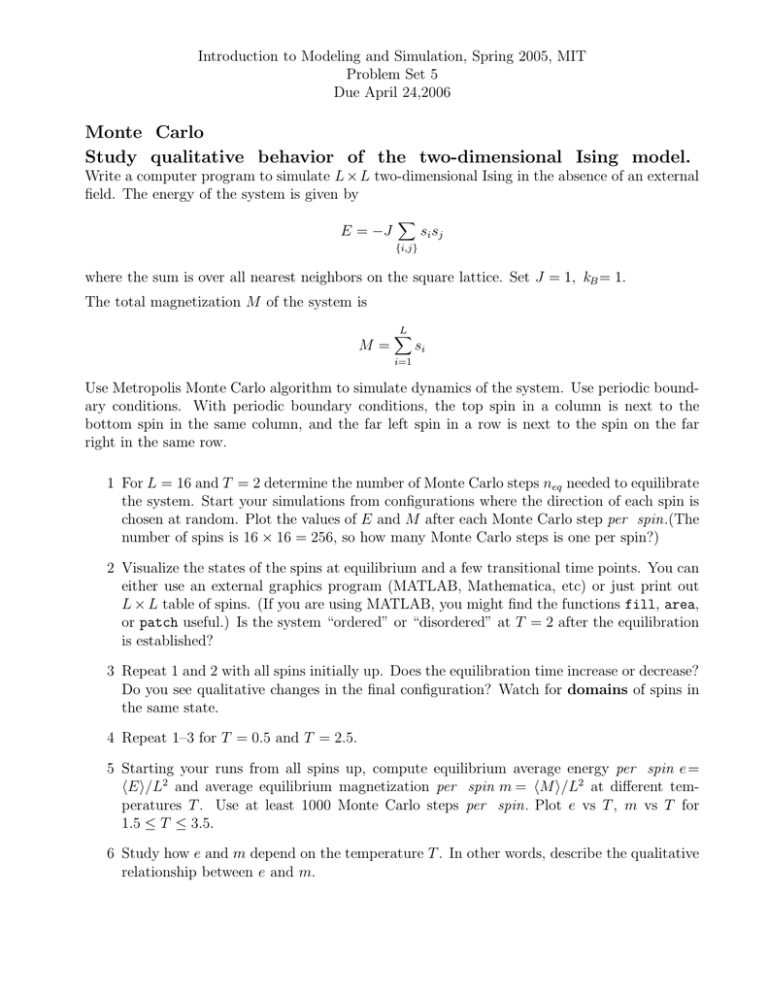Monte Carlo
advertisement

Introduction to Modeling and Simulation, Spring 2005, MIT
Problem Set 5
Due April 24,2006
Monte Carlo
Study qualitative behavior of the two-dimensional Ising model.
Write a computer program to simulate L × L two-dimensional Ising in the absence of an external
field. The energy of the system is given by
E = −J
�
si sj
{i,j }
where the sum is over all nearest neighbors on the square lattice. Set J = 1, kB = 1.
The total magnetization M of the system is
M =
L
�
si
i=1
Use Metropolis Monte Carlo algorithm to simulate dynamics of the system. Use periodic boundary conditions. With periodic boundary conditions, the top spin in a column is next to the
bottom spin in the same column, and the far left spin in a row is next to the spin on the far
right in the same row.
1 For L = 16 and T = 2 determine the number of Monte Carlo steps neq needed to equilibrate
the system. Start your simulations from configurations where the direction of each spin is
chosen at random. Plot the values of E and M after each Monte Carlo step per spin.(The
number of spins is 16 × 16 = 256, so how many Monte Carlo steps is one per spin?)
2 Visualize the states of the spins at equilibrium and a few transitional time points. You can
either use an external graphics program (MATLAB, Mathematica, etc) or just print out
L × L table of spins. (If you are using MATLAB, you might find the functions fill, area,
or patch useful.) Is the system “ordered” or “disordered” at T = 2 after the equilibration
is established?
3 Repeat 1 and 2 with all spins initially up. Does the equilibration time increase or decrease?
Do you see qualitative changes in the final configuration? Watch for domains of spins in
the same state.
4 Repeat 1–3 for T = 0.5 and T = 2.5.
5 Starting your runs from all spins up, compute equilibrium average energy per spin e =
hEi/L2 and average equilibrium magnetization per spin m = hMi/L2 at different temperatures T . Use at least 1000 Monte Carlo steps per spin. Plot e vs T , m vs T for
1.5 ≤ T ≤ 3.5.
6 Study how e and m depend on the temperature T . In other words, describe the qualitative
relationship between e and m.
Optimization by genetic algorithm
Extra Credit. This problem is extra credit. Only fairly good solutions are worth extra credit,
though we will accept solutions to each portion (a numbered item below) separately. Do what
you can with it if you have time. The deadline for extra credit is one week after the problem set
is due. Have fun with this one!
Here your goal is to study “evolution” of organisms in complex environment. The genome of each
organism is encoded by a string of L genes si=1...L = −1 or 1. Genes interact with themselves
(Ji )and with the environment Hi , such that the total fitness of the organism is given by
F (s) =
L−1
�
i=1
Ji si si+1 +
L
�
H i si
i=1
(You might think of Hi as a magnetic field.)
Consider evolution in the population of N organisms sj=1..N . Set values of J and H and start with
random genomes s. At each generation make mutations in the genomes by flipping randomly
picked genes and compute the fitness of each individual. Next select individuals according to
their fitness such that a probability of leaving an offspring for next generation is given by
exp(F (sj )/T )
P (sj ) = �N
k
k=1 exp(F (s )/T )
Make N rounds of selection to obtain N offspring for the new generation. Go back to the
mutation step.
1 Try ferromagnetic interactions between genes, i.e. Ji = 1, L = 6, N = 100, T = 1, introducing N mutations in each round of mutations. Start with no interactions with environment:
Hi = 0. How long does it take to find the ground state energy (i.e. highest fitness)? What’s
the role of T ? Can changing T make your evolution find the ground state faster?
2 Repeat each run at least 10 times. Do you always get the ground state when you start with
random genomes? Try longer L = 10, 20 and smaller population sizes N = 25, 50. How
does efficiency of evolution (i.e. fraction of runs that end at the ground state and number
of generations required) depend on the population size and L?
3 Repeat parts 1 and 2 using the values for environment, Hi , randomly drawn from the
uniform distribution [−1, 1]. In this case you do not always know the ground state configuration, but you can check whether repeated runs (with the same values of Hi but different
starting configurations) generate similar high-fitness genomes. Optional: for short L = 6, 10
you can obtain optimal genomes by complete enumeration. Can you find optimal genomes
for larger L with another method?
4 Optional: Repeat 1 and 2 using no interactions with the environment (Hi = 0) while having
random interactions between the genes Ji (drawn from normal distribution with mean=0
and variance=1). In this case there are several local maxima of fitness and individuals can
“climb” these local maxima and compete. Do you observe this? Remember to try different
values of T . Good luck!
What do these simulations teach us about natural evolution? Can a complicated genome/organism/solution
be found by incremental improvements in large populations? Is it likely that such solution can
be found“by chance” in one generation?




